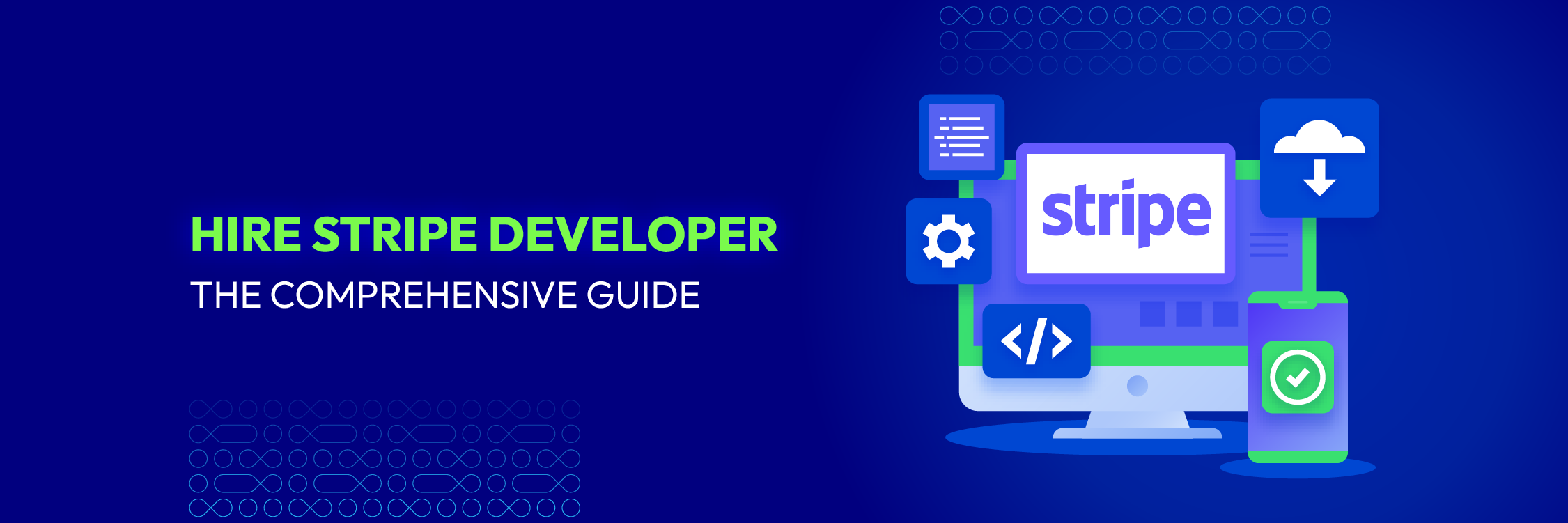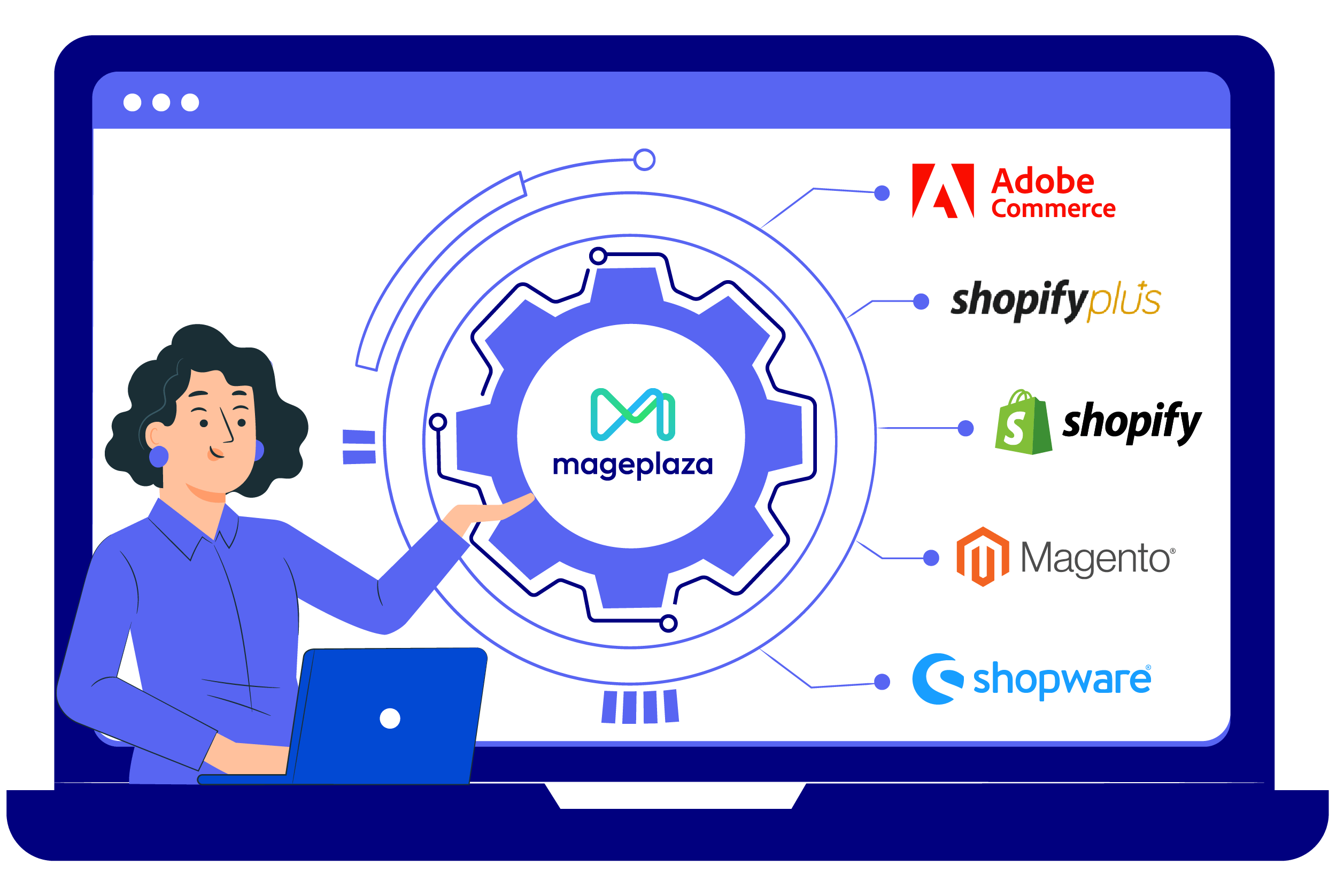Hire Stripe developer: The comprehensive guide
Summer Nguyen | 10-16-2023

Stripe is a game-changing platform that has revolutionized how businesses handle transactions worldwide.
Are you ready to harness the full potential of Stripe for your business? If so, you’ve come to the right place. This blog will provide you with a comprehensive guide on hiring a Stripe developer – the key to unlocking endless possibilities. Let’s dive into it!
Stripe developers – Who are they?
Stripe developers are professionals or teams of software developers who work with the Stripe payment platform. Their job is to implement secure and trustworthy payment processing capabilities into websites, mobile apps, and other software applications.

Stripe is a well-known online payment infrastructure that gives businesses the tools and APIs they need to accept and manage online payments. By integrating with Stripe, developers may create and personalize unique payment processes to match the specific demands of their applications.
Stripe offers a range of APIs that enable developers to handle different aspects of the payment process. This includes functionality like securely collecting payment information, processing transactions, managing subscriptions, and more.
Therefore, Stripe developers are crucial in enabling businesses to accept online payments securely and efficiently. They use Stripe’s APIs and SDKs to create robust and scalable payment solutions that improve user experience and streamline payment processes.
Why do businesses need to hire Stripe developers?
In today’s competitive business landscape, maintaining a stable cash flow is important for the survival and growth of any business. While Stripe, a reliable payment platform, offers developers a relatively simple and straightforward method to help businesses stay afloat.
Stripe developers can incorporate seamless payment solutions, like websites and applications, into their digital products. By leveraging Stripe’s capabilities, businesses can efficiently process payments, send invoices, and safeguard against common security risks like fraud.
Stripe also provides products to cover physical payment demands, including card issuance and digital payments. Its adaptability enables firms to quickly expand and adapt to new growth opportunities.

Even so, fully leveraging Stripe’s functionality requires experience in exploiting its powerful and extensive collection of APIs. Developers who lack fundamental understanding may make mistakes or waste significant time searching for the appropriate endpoints to achieve the desired features.
Having a professional Stripe developer on your development team is extremely important. The objective is to enable a smooth and effective integration of Stripe into digital products and services.
These experts thoroughly understand Stripe’s APIs, seamlessly navigating their complexities and selecting the best solutions for each circumstance. They are also well-versed in avoiding frequent integration mishaps and hazards, guaranteeing a smooth payment experience for your consumers.
While regular developers can eventually grasp the inner workings of Stripe given enough time, not many businesses can afford the luxury of waiting. Hiring a certified Stripe developer is undoubtedly the smart choice if you require swift and effective results.
Their skills and experience will simplify the integration process, allowing your company to swiftly and efficiently harness Stripe’s advantages. By doing so, you can focus on boosting revenue and meeting business objectives without being distracted by the complexity of payment integration.
E-commerce Solution Provider
Over 119,000 global clients have achieved their goals with Mageplaza's help. It's your opportunity to do the same now!
Get StartedWhen to hire Stripe developers?
There comes a time when you need to hire a Stripe developer for your business. Here are the signs you may need to engage some Stripe developers for your team:
- Lack of in-house tech team
Many small and medium-sized teams lack the resources or expertise to manage payment processing infrastructure. These businesses can harness Stripe’s advantages by hiring Stripe developers. This method can eliminate the need to create and operate a complex payment processing platform.
- The specialized skill set of Stripe
Stripe is a complicated platform, there are not only straightforward functionalities that can be quickly installed, but also complex functions. Some developers may attempt to formulate their subscription model but quickly realize that they may benefit from the knowledge of a skilled Stripe developer.

By hiring such specialists, businesses may benefit from their understanding of Stripe’s complexities. This may help speed up the construction of the payment system, and increase their confidence in its operation.
- The in-house tech team is occupied
Even if a company has an in-house tech staff, they may be distracted by other projects or lack the particular skills required to operate Stripe’s API. While they could learn Stripe and implement the integration themselves, employing experienced Stripe experts who can execute the process swiftly is typically more cost-effective. This strategy also lets the in-house team shift the focus to feature development.
- Ensuring accurate implementation
Payment processing is an essential function that must be done correctly the first time around. Companies that hire Stripe developers can reduce the likelihood of issues caused by poor planning or a developer’s lack of platform knowledge. Bringing in specialists raises the chances of a successful implementation and reduces the need for rework or troubleshooting.
What are the everyday responsibilities of a Stripe developer?
The everyday responsibilities of a Stripe developer can greatly vary depending on the project and the needs of the business. However, here are some common responsibilities that a Stripe developer might typically handle:
- Integration and Implementation: A Stripe developer mainly integrates the Stripe payment platform into websites, mobile apps, and other software platforms. This entails utilizing Stripe’s APIs and SDKs to enable payment processing, subscription management, invoice generation, refund handling, and other functions.
- Testing and Debugging: Stripe developers thoroughly evaluate the payment integration to verify its functionality, stability, and compatibility with various devices and platforms. They are responsible for identifying and handling issues or bugs that may develop during testing or in a live environment.
- Customization and Configuration: Stripe developers focus on customizing payment flows to fulfill the business’s particular needs. They establish variables like currencies, payment methods, tax calculations, and delivery options to provide clients with a seamless and personalized payment experience.

- Security and Fraud Prevention: Stripe developers are critical in putting in place security measures to protect sensitive payment information and prevent fraudulent transactions. They use Stripe’s anti-fraud tools and best practices for payment data security, such as encryption and secure tokenization.
- Upgrades and Enhancements: Developers are responsible for staying current with the latest technological advancements. They must make any necessary upgrades or additions to the existing payment integration as Stripe delivers new capabilities or updates its APIs.
- Ongoing Maintenance and Support: Stripe developers may be responsible for continuing maintenance and support beyond the initial integration. Monitoring the payment system, correcting any performance issues or faults, and giving technical assistance to resolve payment-related difficulties are all part of the job.
- Documentation and Collaboration: Stripe developers may describe their integration processes for clarity and as a reference for future maintenance or upgrades. They may also work with other team members, such as product managers, designers, or fellow developers, to match the payment integration with the overall product roadmap and user experience.
What skills should you look for in a Stripe developer?
Merely hiring a Stripe developer is insufficient; finding the right fit with the necessary skills is essential to meet the specific requirements of your projects. Here are key skills to consider when seeking out Stripe developers:
- In-depth understanding of Stripe and its APIs: It is crucial to find someone with comprehensive knowledge who feels at ease working with Stripe’s services, features, and functionalities. This expertise is necessary for their day-to-day tasks and valuable in guiding the development team and determining the most effective approaches when implementing features in your projects. Your ideal candidate should be well-versed in the specific Stripe API endpoints required to address any development needs that may arise.
- Proficiency in at least one programming language supported by Stripe: Stripe’s APIs can be accessed using various programming languages, such as Ruby, Python, Go, Java, Node.js, PHP, and .NET. Ensure your candidate is proficient in a language compatible with Stripe’s API. Ideally, their proficiency should align with the programming language used in your project, but if not, it is important to research and determine the preferred language for integration.

- Understanding of best practices for handling financial information and payments: While Stripe handles the payment aspect of a user’s transaction, it remains the responsibility of the receiving party to securely store and manage that information on their end. Given that the Stripe developer will be the primary handler of this information, they must be knowledgeable about industry best practices. This will help them handle sensitive financial information and ensure secure payment processing.
- Familiarity with database technology: The familiarity with databases will depend on the particular project and how you plan to integrate Stripe. However, it is beneficial for your candidate to be comfortable working with SQL and NoSQL databases and possess knowledge of methods to manipulate and interact with them effectively.
- Deep knowledge of developing robust RESTful APIs: A Stripe developer should have a solid understanding of REST principles and design APIs that are intuitive, consistent, and follow industry best practices. They should be familiar with implementing authentication methods such as API keys, OAuth, or JWT (JSON Web Tokens).
- In-detail knowledge of Linux operating systems and command-line interface (CLI) scripting: Understanding Linux OS allows developers to effectively navigate and manage the server environment, perform system configurations, and troubleshoot issues. CLI scripting skills enable developers to automate tasks, write efficient shell scripts, and interact with the system at a granular level.
How much does it cost to hire a Stripe developer?
The average cost of hiring Stripe developers can range from $30 to $200 per hour. This cost varies depending on the developer’s experience level, location, project scope, and engagement type. Here are some general cost considerations:
- Freelance Stripe Developers: Freelancers typically charge either an hourly rate or a fixed project rate. Hourly rates can range from around $30 to $150 or more, depending on the developer’s experience and location. For fixed project rates, the cost will depend on the project’s complexity and estimated time for completion.
- Development Agencies: Hiring a development agency for Stripe integration projects often involves a different cost structure. The cost can be from $5,000 to $20,000 or more for relatively simple Stripe integration projects with basic features and functionality. For projects with moderate complexity, the cost can range from $20,000 to $50,000. The cost for large-scale projects can range from $50,000, depending on the project’s complexity and requirements.
- In-House Developers: For junior Stripe developers, you may expect to pay them $50,000 to $80,000 per year. For mid-level developers, the cost can range from $80,000 to $120,000. For senior developers, the cost of hiring can range from $120,000 to $180,000 or more.
Where to hire a Stripe developer?
When looking to hire a Stripe developer, there are several ways you can explore to find qualified candidates. Here are some popular options:
- Tech job boards: Websites dedicated to tech job advertising, such as Stack Overflow Jobs, GitHub Jobs, and AngelList, attract developers with various talents, including Stripe integration knowledge. These platforms enable you to post job advertisements and receive applications directly from interested developers.

- Developer communities and forums: Connecting with experienced Stripe developers can be easier by participating in developer communities and forums like Reddit, Hacker News, or Stripe’s developer community.
- Online freelance platforms: Sites like Upwork, Freelancer, and Toptal offer a diverse choice of freelance developers, including those with Stripe integration experience. You can publish your job requirements, browse freelancer profiles, and conduct interviews to locate the best applicant for your project.
- Job recruitment platforms: Use job recruitment platforms such as Indeed, Glassdoor, or LinkedIn Jobs to advertise your job listing and attract Stripe developers actively looking for work.
8 steps to successfully hire a Stripe developer
Step 1: Defining project requirements
As you embark on the hiring journey, it’s crucial to establish a clear understanding of your project requirements. Take the time to define the specific tasks you expect your chosen Stripe developer to undertake. Whether it’s seamlessly integrating Stripe into your website, crafting tailored payment flows, or implementing robust recurring billing functionality.
By grasping the scope of your project and identifying any specialized expertise necessary, you pave the way for a more efficient and effective hiring process.
Step 2: Selecting the suitable hiring model
When making hiring decisions, you need to carefully select the most suitable model for your business needs. Consider the range of options available, such as full-time employees, freelancers, or outsourcing agencies. Consider crucial factors such as the projected duration of your project, budgetary considerations, the desired level of control, and any long-term support requirements.

Here are 3 common hiring models you should consider:
- Outsourcing Stripe developers
This is a hiring model where individuals or teams are engaged for a specific project or limited duration, working under a contractual agreement. Once the contract concludes, these professionals are free to pursue other projects. Notably, the distinction from remote work lies in their affiliation with an agency, which enhances their accountability.
This model allows you to gain prompt access to skilled professionals or teams who are readily available to commence work. This model can be a cost-effective alternative to direct hiring, depending on the project duration.
However, with this model, ensuring consistent work quality may not be guaranteed, requiring thorough monitoring and quality control. And conducting a legal review of the contract may involve additional expenses if legal expertise is not readily available within the organization.
- Hiring freelancers
Freelancers are independent professionals who operate without formal ties to any specific company. They can take on jobs, potentially working on multiple projects simultaneously, before moving on to the next assignment. These freelancers are easily accessible through professional social networks like LinkedIn or specialized platforms like Upwork.
Freelancers offer the advantage of being highly specialized, allowing you to find individuals with specific skills that align closely with your project requirements. They often offer more competitive rates than hiring full-time employees, making them a cost-effective choice for certain projects.

However, finding and hiring the best freelancer for your project can be time-consuming, requiring thorough evaluation and vetting of candidates. Unlike full-time employees, freelancers’ work quality may vary, requiring careful supervision and quality control measures.
- Recruiting agencies
Outsourcing the hiring process to recruiting agencies can be a good way to find a highly qualified Stripe developer. Agencies can help businesses locate full-time employees that meet the job requirements and are culturally compatible. This model is suitable for long-term or small-scale projects in succession.
Step 3: Posting the job description
Creating a precise and captivating job description that will attract potential candidates is crucial. Ensure clarity in your expectations for the developer you intend to hire. Include the following details:
- Comprehensive solution overview: Provide a thorough overview of the integration project, describing the nature and purpose of the solution that needs to be implemented.
- Required technologies and languages: Specify the technologies, programming languages, and frameworks the developer should know to successfully execute the integration.
- API usage requirements: Outline the specific API functionalities and usage involved in the integration project, highlighting any relevant experience or expertise required.
- Job duration and compensation expectations: Communicate the expected duration of the job, including any potential long-term commitments, and provide information about the remuneration and benefits associated with the position.
Step 4: Screening potential candidates
Initiate the hiring process by conducting a pre-screening phase with a recruiter. This step involves evaluating candidates to determine whether they fit your company well.
You should look for candidates with good Stripe development expertise and familiarity with essential programming languages.
Don’t forget to examine their prior work, portfolios, and any references they mention. Use this opportunity to gauge their interpersonal skills and overall compatibility. Identifying mismatches early on helps avoid wasting time for both parties involved.
Step 5: Conducting initial interviews
Proceed to a technical interview where you assess the candidate’s technical knowledge, analytical abilities, and familiarity with the Stripe platform. This stage aims to gauge their foundational understanding and capabilities without delving into specific details.

If two candidates perform equally well in this stage, the subsequent step will typically provide clarity in choosing the better fit. Consider the following points:
- Engage a senior developer or a technically literate recruiter to conduct the technical interviews. This ensures effective communication in technical terms and accurate evaluation of candidate responses.
- Prepare questions relevant to the job requirements, tailored to evaluate the candidate’s readiness to tackle challenges associated with the app and Stripe integrations.
Here are a few questions to ask when you hire a Stripe developer:
- In your opinion, what are the fundamental principles that drive software engineering?
- Can you describe your approach to integrating Stripe into our software?
- If provided with a collection of payment entries, how would you find a specific entry?
- How would you design a system capable of efficiently storing a substantial volume of payment entries?
- What strategies or enhancements would you suggest to improve the functionality of [this specific payment method]?
Step 6: Testing the candidate’s skills
Following the technical interview, include a coding challenge or small project to further assess the candidate’s skills in a simulated work environment. This coding exercise provides a practical evaluation of their abilities and proficiency.
You can request the candidates to demonstrate their practical skills and problem-solving abilities through some tasks. This may include performing tasks such as creating a fundamental payment flow, incorporating a customized feature, or resolving a common issue. This evaluation step allows you to gauge their firsthand experience with Stripe and evaluate their capacity to deliver successful outcomes.
Step 7: Making an offer and signing the contract
After identifying the ideal Stripe developer, extend an offer specifying essential details such as salary, benefits, work hours, and any other relevant terms. Preparing for potential negotiations is important, ensuring a mutually satisfactory agreement.
Step 8: Onboarding the new developer
Once the offer is accepted, ensure a smooth onboarding process by providing the necessary materials and resources to the developer. This includes granting access to relevant systems and tools essential for their work. Additionally, furnish them with comprehensive documentation and any additional resources that will assist them in quickly familiarizing themselves with their role and responsibilities.
Summary
In conclusion, hiring a Stripe developer requires a thoughtful and strategic approach. Following the comprehensive guide can streamline the hiring process and increase the likelihood of finding the right candidate for your specific project needs. With these strategies outlined, you can confidently hire a Stripe developer who will contribute to the success of your business.









